New 2010 Introductions
New introductions primarily from our own wild seed collections that will become available during the course of the new season. Here divided into 3 sections:
Woodies including some climbers
Starting with Acer, we have identified a couple of interesting collections from northern Vietnam. A. fabri WWJ11614 is known although very difficult to track down, bearing simple lance-shaped evergreen leaves that emerge in shades of pink and yellow, maturing to dark glossy green. A somewhat similar species which we have also found in that area also only forms a small tree or large shrub, , A. laevigatum BSWJ11684has leaves glossy on their upper surface held on shorter petioles.
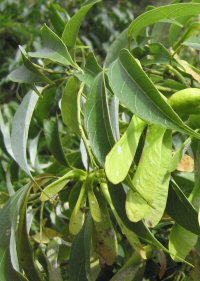 |
Acer oblongum KWJ12232
A. oblongum KWJ12232 is an old friend which we are offering as a replacement collection from a shrubby plant we found while on a new (to us) trail through the Hoang Lien Mountains. Unmistakable with again simple, but oblong paler glossy leaves almost white below complemented by a wonderful crop of fat large winged seed.
|
 |
It was only last year that I finally identified Acer mono v. marmoratum f. dissectum BSWJ8914, not surprised with that string of names. All the same they are one of the most colourful maples bearing good yellows through to deep reds by autumn.
|
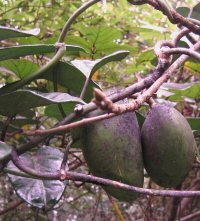 |
Marsdenia formosana CWJ12354
Marsdenia formosana CWJ12354 was one of the first collections on my return to Taiwan in 2007, this time with Finlay Colley and Dan Hinkley. The distinct large seed capsules were dangling over the sodden mountain road where the twinning stems with large glossy leaves had grown into the canopy of a Lagerstroemia.
|
Maesa japonica CWJ12371 is a scandent species we found in the mountains of the western side of Taiwan, with its evergreen branches heavily laden with masses of small pink fruit. Similar in being admired for its fruit is Callicarpa aff. tikusikensis BSWJ7127, this time from the north of the island, somewhat more downy and more persistent in foliage that C. formosana.
Trochodendron aralioides from Taiwan has always been popular here differing substantially from its Japanese counterpart by its larger glossy leaves and faster growth. In that respect my collection CWJ12357 should not differ from our previous collections, apart from its apple green colourations.
 |
Stachyurus sigeyosii
Also from my 2007 sortie are two collections of Stachyurus sigeyosii from selected plants with longer inflorescences growing at a higher elevation than previous finds.
|
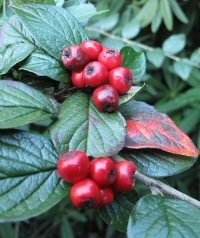 |
Cotoneaster hualiensis BSWJ3143
Cotoneaster hualiensis BSWJ3143 is named after the county we discovered it in, growing at the base of shady cliffs on a long abandoned logging trail the Japanese carved into the forests in the high mountains of north-eastern Taiwan. Where it formed a small deciduous tree bearing almost rounded sizeable glossy leaves with conspicuously embossed venation, embellished with clusters of large bright red fruit by late summer.
|
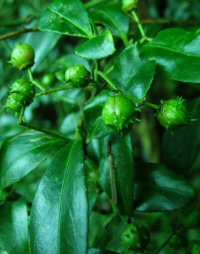 |
Euonymus spraguei CWJ12446
We also found Euonymus spraguei on this trail, but only successfully germinated seed from the 2007 expedition. This is a lax evergreen shrub in juvenility, maturing to larger elliptic leaves on slender green stems to 2m tall bearing panicles of curious rounded fruiting capsules covered in curved spines.
|
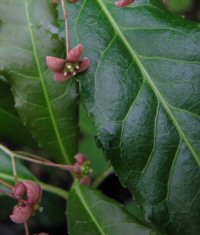 |
Euonymus aff. theaefolius GWJ9377
Another new species E. theaefolius GWJ9377 was a collection from the Darjeeling area of northern India, where it formed neat shrubs bearing Camellia-like foliage with pink capsules holding the orange aril covered seed all held on long slender stalks.
|
 |
Hydrangea aspera ssp. robusta GWJ9430
This area it so happens is the epicentre of distribution of the fabled Hydrangea aspera ssp. robustum. We have seen all sorts offered as this in a desperate attempt to fill the vacuum,
|
small wonder as it is worthy of its space on foliage alone, boasting some of the largest leaves of the genus, held on long red petioles. Flowering a little earlier for us in cultivation, thankfully as it only starts in October in the wild. Hence the difficulty in collecting seed.
The hydrangeas of this botanically rich area of Vietnam are fascinating, keeping me amused for hours. I once stumbled across a small shrub in a heavily degraded and grazed boggy forest with all purple foliage.
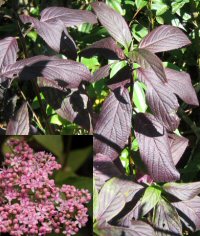 |
Hydrangea lingii BSWJ11790
While contemplating our retirement plans the resulting cuttings were growing in our quarantine unit here at Crûg. H. lingii (I later ascertained) is capable of this ornamental attribute, but not to any great extent in North Wales.
|
We were initially disappointed with its floral display as well, there were no sterile florets, but as it matures it is most certainly appealing neither brash nor too subtle to be noticed.
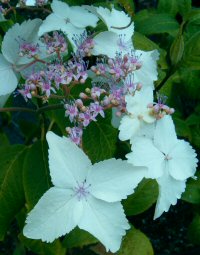 |
|
Hydrangea kwangsiensis BSWJ11717
Other closely related species are emerging (from the H. indochinensis complex) H. kwangsiensis BSWJ11717 is one such collection from close to the border with China, with blue veined leaves more reminiscent of Dichroa, but with strong blue ornate lace-caps (in acid soils).
|
|
|
|
Blue is the preferred colour of our collection of H. serrata BSWJ6241a from southern Japan, appropriately named at the end.
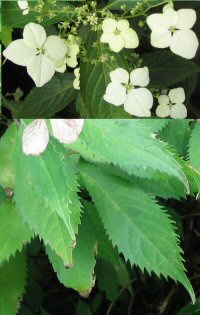 |
Hydrangea grossiserrata BSWJ11500
H. grossiserrata BSWJ11500 is one I have been scratching my head over for years. A small aptly named species we collected from medium altitudes on Yakushima with an affinity to H. scandens ssp. liukiuensis BSWJ11471 which we also found there at a lower altitude, this latter species closer to H. luteo-venusta. The climbing species we find there
|
known as
H. yakushimensis by the Japanese, is also categorised as variety
cordifolia of
H. anomala ssp. petiolaris.
var. tiliifolia from the island of Ullüngdõ (mix up).
Moving on smartly to their cousins, Deutzia crenata v. nakaiana BSWJ11184 takes us out of the frying pan and into the fire. This is our first collection of this variety with smaller but more numerous flowers, BSWJ8879 is moved to var. heterotricha. If you consider my taxonomic skills woeful, listen on…....
D. scabra BSWJ11127 will be the first correctly named introduction of this species into British horticulture since its mix-up in 1877. What we have been growing under that name is D. crenata. Obvious once it has been pointed out. It goes on, D. coreana BSWJ8588 is now considered to be D. prunifolia (the illustration was upside-down in the Flora of Korea, honest). No mistaking D. paniculata, also from Korea with its large panicles of small white flowers in profusion May-July, setting this species well apart from others.
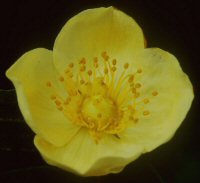 |
Philadelphus myrtoidea BSWJ10436
Before we leave the hydrangea family I must mention Philadelphus myrtoidea BSWJ10436, astonishing when we found this in the high mountains of northern Guatemala with yellow
|
flowers, disappointingly only white have been produced on the single plant that has flowered for us so far.
Moving further south we collected Vaccinium consanguineum BSWJ10486 on the Cordillera de Talamanca, Costa Rica, where it grew high up in the clouds mimicking something from the myrtle family with small glossy leaves and plump black fruit. From the eastern side of the United States comes Viburnum prunifolium, where it is valued for its autumnal hues as well as the black edible fruit.
Moving smartly back to Asia we are adding a couple of collections of Weigela from Japan, namely W. decora and W. floribunda neither have flowered as yet to confirm their identities. Styrax obassia BSWJ10890 is taking the place of our previous collection, this collection will definitely not disappoint, growing well in our exposed field already.
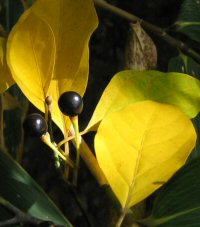 |
Lindera umbellata v. membranaceae BSWJ10837
There are also some additional collections of the increasingly popular Lindera from Japanese woodlands, L. obtusiloba will require no introduction, but L. umbellata and its variety membranaceae may. Irresistible with their butter yellow small foliage and black fruit in the autumn held on dark stems.
|
|
|
|
Further south from the coastal area of northern Taiwan I collected the seed of what appears to be the shrubby species D. teysmannii, which enjoys that exposed maritime environment.
 |
Daphniphyllum majus BSWJ11744
Not so with D. majus BSWJ11744, yet another new species to cultivation from northern Vietnam, where they form impressive small trees with 30cm long rugose leaves and grape-like pendant panicles of rounded blue-black fruit.
|
Will anyone ever appreciate the time that we have spent searching for the fruit of these trees? It must be substantial by now.
 |
Gamblea pseudoevodiifolia BSWJ11707
Gamblea pseudoevodiifolia BSWJ11707 also hails from this area, still think that Evodiopanax was a far more descriptive name for this Schefflera-like taxon, with evergreen leaflets and black panicles of fruit.
|
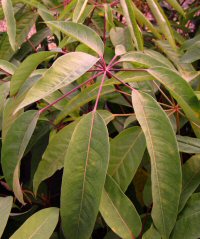 |
Schefflera aff. myriocarpa BSWJ11828
Finally we are able to offer plants of the shrubby Schefflera aff. myriocarpa BSWJ11828, all be it probably late in the season. A collection from a higher altitude than others of this group that have a false or additional whirl of foliage.
|
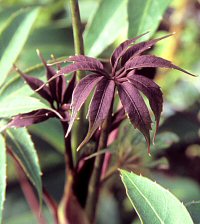 |
Schefflera alpina BSWJ11827
S. alpina BSWJ11827 has taken a while to grow large enough to offer. Finally this species with colourful new purple growth, from high up on the mountain tops of northern Vietnam will be ready for the spring of 2010
|
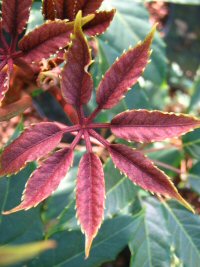 |
Schefflera aff. chapana BSWJ11833
along with the other much asked for S. aff. chapana BSWJ11833. I do make myself unpopular by refusing to sell these until they are large enough to be planted, it may not even make commercial sense to grow them to a size, but the last thing we wish to happen is for them to acquire an ill-founded reputation of being tender. When all they require is a little time to form some wood.
|
This laurel relative from the forests of Fansipan, was irresistible with glossy orbicular foliage with pronounced venation and long drip tips, while the fruit were a bright red in conspicuous clusters.
 |
Tripterygium aff. wilfordii WWJ12009
The name Tripterygium hypoglauca was used last year, but as ever the epithet has been transferred to T. wilfordii WWJ12009, a name coined for the incorrect plants for many years. While we have retained T. hypoglauca for the Chinese collections. I am somewhat astonished on excursions of our field grown stock beds when people are so pleasantly impressed on encountering the horticultural merits of this genus as if it were for the first time. They have been in cultivation for around a century yet nobody thought of growing this woody climber as a shrub.
|
The excitement when we found C. fasciculiflora KWJ12160 was memorable, just a small branch poking its head out from dense undergrowth, even several other clematis were competing in this limestone area of northern Vietnam. The ornamentation of foliage displayed on the young plants has been exceptional, creating difficulty in selecting plants for our own garden.
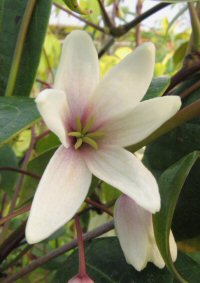 |
Holboellia brachyandra HWJ1023
While Holboellia brachyandra HWJ1023 from the same valley all be it from the acidic side, is back on our list with a new name, I will not extol its qualities too much or there will be too much demand, as this year at least we will not have many plants. Incidentally both this and Schefflera taiwaniana have been rejected by the trade (mass) of Europe as they cannot believe they are hardy. Yet in the USA they are gearing up for a huge demand, of course Europe will end up importing them. Lack of foresight or what………..?
|
As can be seen this is one identified by Peter Wharton, whom I was hoping could tutor me on this genus before his untimely death last year.
 |
Magnolia foveolata WWJ11929
Magnolia foveolata WWJ11929 was from way up north on the border with China, where they formed large stands of small trees.
|
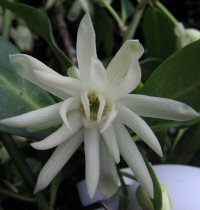 |
Illicium majus WWJ11919
It is from this same area that we collected the unmistakable (star-anise-like) seed capsules of Illicium majus WWJ11919, once included in the same family as magnolia. Hardly surprising as this,
|
yet another new species to cultivation, has luxuriant foliage to 20 cm long. The middle sections of the leaves are undulate, rendering them easily identifiable even when the scented white flowers are not to be seen.
Schisandra aff. plena BSWJ664 is mentioned here as a close relative, because we have been forced into yet another name change as the previous taxon has been transferred to Kadsura. Not to be forgotten is another collection of Dan’s, Pittosporum aff. oblongilimbum DJHV06137 with pleasing evergreen small undulating foliage, not flowered for us yet, but money on it to be scented.
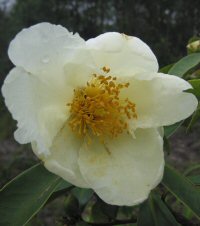 |
Polyspora longicarpa WWJ11604
The Polyspora we introduced last year has been well received, this year we have a stable mate P. longicarpa WWJ11604 from our collection gathered near the Tram Ton Pass with the Whartons in 2006. A species with long seed capsules and narrower foliage, but still with the wonderful white camellia-like large flowers held in the autumn.
|
While P. villosa v. coreana BSWJ8789 is a variety of this colourful yet little known species also valued for its edible fruit and gorgeous autumnal foliage.
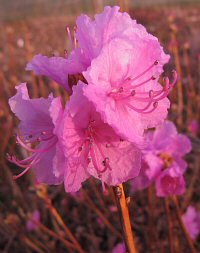 |
Rhododendron mucronulatum v. taquetii BSWJ4486
Rhododendron mucronulatum v. taquetii BSWJ4486 from the cold eastern parts of Korea is seldom seen, a deciduous species which can flower as early as January on the bare stems. There will be other similar species added through the season time permitting to identify them.
|
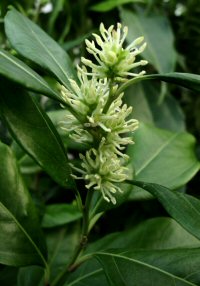 |
Sarcococca trinervia BSWJ9500
Sarcococca trinervia BSWJ9500 is a collection from close to Ooty a hillstation in the Nilgiri Hills of southern India, better known for growing tea. Here it lined the roads as we drove to the summit of the highest peak, wish it was all as easy as that.
|
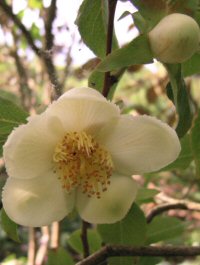 |
Stewartia rostrata
Finally a few woodies we are adding to our list from cultivation. Stewartia rostrata has formed a small delicate tree in our walled garden where it has long been admired for its small foliage and abundance of white flowers. |
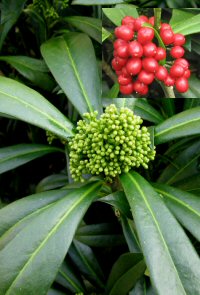 |
Skimmia anquetilia
We’ve been having fun for years encouraging guests to our walled garden to rub the leaves of the male then female plants of Skimmia anquetilia, try it and see what it proves.
|
 |
Aucuba japonica 'Viridis'
Aucuba japonica 'Viridis' is yet another from the same garden which we keep on being asked for, wonderful display of red fruit in spring highlighted by the deeply toothed glossy (un-spotted) leaves.
|
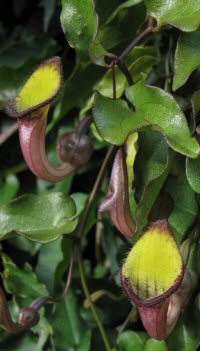 |
Aristolochia sempervirens
Then Aristolochia sempervirens refuses to stop flowering all summer and autumn, yet another wonderful plant from Louisa Arbuthnott of Stone House Cottage Nurseries. There is a lady with an eye for a good plant.
|
Not forgetting Daphne genkwa, been on my list to plant out on top of a sunny stone wall for a while, always too busy in the spring, such is a nurseryman’s lot.